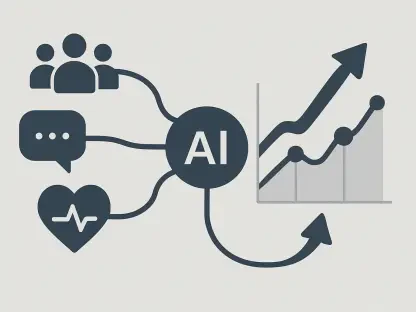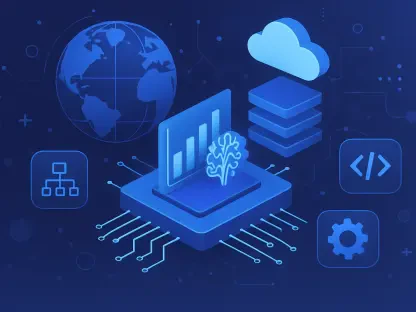Artificial Intelligence (AI) is rapidly reshaping the landscape of data analytics and decision-making. By integrating AI-driven technologies like natural language query (NLQ) and chatbots, organizations across various sectors are unlocking unprecedented analytical capabilities. This evolution necessitates data and analytics leaders to not only stay current with these advancements but also strategically navigate the arising challenges. The intersection of AI and analytics represents a paradigm shift in how data is processed and used to make informed decisions, bringing both efficiencies and complexities to the table.
The Intersection of AI and Analytics
The integration of AI into analytics is a game-changer. Traditional tools like spreadsheets continue to reign due to their simplicity and widespread use. However, the advent of AI-enabled generative chatbots has introduced a new dimension to data analysis. These tools allow users to perform complex analyses intuitively, minimizing the need for extensive training or specialized software. As these technologies advance, they provide a more natural interaction with data, making sophisticated analytics accessible to a broader audience.
Yet, the rapid adoption of these tools often leads to governance challenges. For instance, analytics work conducted outside conventional Advanced Business Intelligence (ABI) platforms can result in governance policy breaches. As predicted by Gartner, by 2025, 40% of ABI platform users might sidestep established governance processes using generative AI chatbots. This trend poses a significant risk to maintaining data integrity and compliance, necessitating proactive governance measures to keep in step with technological progress.
The Spread of Spreadsheets and Governance Challenges
The convenience of AI chatbots in analyzing spreadsheet data fuels a proliferation of spreadmarts—essentially isolated silos of spreadsheet data. This phenomenon necessitates a closer collaboration between data analysts and IT departments to manage and govern these generative data silos effectively. The lack of centralized oversight can lead to inconsistencies and errors, making it imperative to develop strategies that balance ease of use with rigorous governance standards.
Gartner’s forecast that over 70% of independent software vendors (ISVs) will embed generative AI capabilities into enterprise applications by 2026 underscores a shift from traditional analytics tools to AI-driven solutions. This shift highlights the displacement risk for conventional analytics vendors who might struggle to keep up with this rapid technological integration. As AI continues to permeate analytics applications, traditional platforms must evolve or risk obsolescence in the face of more agile, intuitive alternatives.
Strategic Recommendations for Data and Analytics Leaders
To harness the benefits of AI in data analytics, organizations need to invest in training modules specifically designed for business analysts and augmented analytics users. Such training ensures that personnel can leverage GenAI effectively and securely. Comprehensive education programs are vital to maximizing the utility of these advanced tools while adhering to governance and compliance requirements. These programs should focus on practical applications, ethical considerations, and emerging trends in AI technologies.
Additionally, data and analytics leaders must strategically incorporate NLQ chatbots into their operational models. Doing so positions these chatbots as catalysts for technological innovation and efficiency. Furthermore, integrating ABI platforms with large language models (LLMs) ensures their ongoing relevance by enabling seamless data retrieval and prompt engineering. Such integration not only enhances the user experience but also enables more accurate and efficient data analyses, bridging gaps between data accessibility and analytical power.
Promoting a culture of collaboration is equally important. Encouraging the collective sharing of insights derived from GenAI chatbots can foster a more informed and adaptive organizational environment. This approach also helps mitigate the potential for AI-induced misinformation or hallucinations. By building an ecosystem where data insights are openly communicated and collaboratively refined, organizations can turn collective intelligence into a strategic advantage, ensuring more robust and reliable decision-making processes.
Ethical Considerations in Predictive Analytics
The increasing reliance on predictive analytics poses significant ethical questions, particularly in sectors like public safety. It is imperative for public safety organizations to develop and implement ethics frameworks by 2026 to guide the responsible use of these analytics tools. These frameworks should address potential biases, the impact on privacy, and the broader societal implications of AI-driven decision-making. Establishing clear ethical guidelines helps prevent misuse and builds public trust.
Transparency is crucial to maintaining public trust. Government CIOs must enforce stringent transparency measures, ensuring vendors disclose their AI models and methodologies. This practice safeguards public interest and adheres to departmental policies, reducing the risk of overreach and unethical use of data. Open communication about how data is used and the algorithms involved promotes accountability and trust, essential elements for fostering community support and cooperation.
Community verification processes are also vital. Involving communities in validating the use of predictive analytics fosters a sense of trust and accountability, ensuring that AI implementation is both ethical and effective. By providing mechanisms for public input and oversight, organizations can ensure that their use of AI aligns with societal values and expectations. This collaborative approach not only strengthens ethical standards but also enhances the overall effectiveness and acceptance of predictive analytics in public safety.
The Growing Prominence of AI in Enterprise Applications
The embedding of generative AI capabilities within enterprise applications marks a significant transformation. This trend suggests that most ISVs are gearing up to incorporate AI tools into their offerings, fundamentally altering how data analytics is conducted across industries. As these capabilities become more widespread, they are set to redefine industry norms, pushing the boundaries of what can be achieved with data-driven decision-making. Organizations must stay ahead of this curve to remain competitive and harness the full potential of AI-enhanced analytics.
As more organizations adopt AI-driven solutions, there’s an observable shift from traditional ABI platforms to more intuitive, embedded AI tools. These tools are favored for their seamless integration within natural workflows, offering a more user-friendly approach to data analytics. The ease of use and accessibility provided by these advanced tools help democratize data analytics, allowing more stakeholders to contribute insights and make data-driven decisions without extensive technical expertise.
Addressing the Challenges of AI Integration
While AI offers transformative benefits, its integration is not without challenges. The swift rise of generative data silos and the bypassing of established governance frameworks demand a revised approach to data management. Close collaboration between IT departments and data analysts becomes crucial to maintaining effective oversight and minimizing risks. Such partnerships can ensure that AI tools are used responsibly and that data governance policies are adhered to, preserving data integrity and security.
Moreover, establishing robust ethics frameworks becomes increasingly important as AI’s role in predictive analytics grows. Ensuring transparency and engaging the community in the validation process are essential steps toward building a trustworthy AI ecosystem. Ethical considerations must be at the forefront of AI deployment, addressing concerns related to bias, fairness, and the societal impacts of AI-driven decisions. By proactively addressing these issues, organizations can achieve a balance between innovation and responsibility.
Conclusion
Artificial Intelligence (AI) is swiftly transforming the realm of data analytics and decision-making. By incorporating AI-driven tools such as natural language query (NLQ) and chatbots, organizations are unlocking new levels of analytical prowess across various industries. This rapid evolution requires data and analytics leaders to not only keep up-to-date with these technological advancements but also to skillfully navigate the associated challenges. The convergence of AI and analytics marks a fundamental shift in how data is processed and utilized to make well-informed decisions, offering both efficiencies and complexities.
Moreover, AI’s role in automating repetitive tasks and generating real-time insights significantly enhances operational efficiency. AI’s predictive capabilities enable businesses to anticipate trends, thereby gaining a competitive edge. However, this technological leap also brings complexities, such as data privacy concerns and the need for robust cybersecurity measures. Leaders must therefore adopt a strategic approach, balancing innovation with ethical considerations. The successful integration of AI in analytics can yield transformative results, but it demands careful planning and a forward-thinking mindset.









